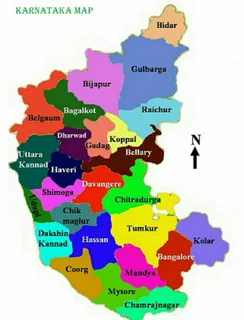Hey there, fellow explorers! Are you curious about Karnataka and its beautiful geography? You’re in the right place. Today, we’re going to dive deep into the Karnataka map and discover everything this amazing state has to offer. Whether you’re a student, tourist, or just someone who loves geography, this guide will help you understand Karnataka like never before.
Karnataka is truly one of India’s most fascinating states. From bustling cities to serene hill stations, this state has it all. Let me take you on a friendly journey through the Karnataka map and show you why this state is called India’s Silicon Valley and Garden State.
Understanding Karnataka’s Geography and Location
Karnataka sits beautifully in South India, bordered by several states that add to its charm. The Karnataka map shows borders with Goa and Maharashtra to the north. Andhra Pradesh and Telangana touch its eastern boundaries. Tamil Nadu and Kerala complete the southern and western borders respectively.
The state covers an impressive area of about 191,791 square kilometers. This makes Karnataka the sixth-largest state in India by area. The Arabian Sea forms its western coastline, giving Karnataka some stunning beaches. The state’s strategic location has made it a major hub for trade, technology, and tourism over the years.
The 31 Districts That Make Karnataka Special
When you look at any Karnataka map, you’ll notice it’s divided into 31 districts. Each district tells its own unique story and contributes to the state’s overall development. These districts are grouped into four main administrative divisions for better governance and management.
The districts vary greatly in size, population, and economic activities. Some districts like Bengaluru Urban are technology hubs with modern infrastructure. Others like Coorg (Kodagu) are famous for coffee plantations and natural beauty. This diversity is what makes exploring the Karnataka map so exciting and educational for everyone.
Exploring the Four Administrative Divisions
Karnataka’s administrative structure includes four main divisions: Bengaluru, Belagavi, Mysore, and Kalaburagi. Each division has its own headquarters and manages several districts under its jurisdiction. This system helps in better administration and development planning across the state.
The Bengaluru division includes the capital city and surrounding areas. It’s the most developed region with excellent connectivity and infrastructure. The Belagavi division covers the northern parts, known for its agricultural productivity. Mysore division includes the cultural heartland, while Kalaburagi division manages the northeastern districts. Understanding these divisions helps you navigate the Karnataka map more effectively.
Bengaluru: The Capital City That Leads the Way
Bengaluru, with over 15 million residents, stands as Karnataka’s largest city and state capital. When you examine the Karnataka map, Bengaluru’s central location becomes immediately apparent. This positioning has helped it become India’s technology capital and a global IT hub.
The city’s growth has been phenomenal over the past few decades. From a pensioner’s paradise to a bustling metropolis, Bengaluru attracts people from across India and the world. The city’s pleasant climate, excellent educational institutions, and job opportunities make it a preferred destination. Its presence significantly influences how people perceive and use the Karnataka map for various purposes.
Major Cities and Their Unique Characters
Karnataka’s cities each have distinct personalities that shine through on any detailed Karnataka map. Mysore enchants visitors with its royal heritage and magnificent palaces. Mangalore serves as a major port city, connecting Karnataka to international trade routes. Hubli-Dharwad forms a twin city known for its commercial activities and educational institutions.
Belgaum (now Belagavi) holds historical significance and serves as the state’s second capital during winter sessions. Gulbarga (Kalaburagi) represents the northern region’s cultural richness. Each city contributes uniquely to Karnataka’s economy and cultural landscape. These urban centers form important reference points when navigating the Karnataka map for travel or business purposes.
Physical Features That Define Karnataka’s Landscape
The Karnataka map reveals fascinating geographical diversity that few states can match. The Western Ghats run along the western edge, creating beautiful hill stations and wildlife sanctuaries. The coastal plains stretch along the Arabian Sea, offering pristine beaches and fishing communities.
The Deccan Plateau covers most of the state’s interior regions. This plateau provides fertile land for agriculture and hosts several important rivers. The varied topography means Karnataka experiences different climates across regions. Understanding these physical features helps you appreciate why the Karnataka map shows such diverse land use patterns and settlement distributions.
Rivers and Water Bodies Across the State
Water resources play a crucial role in shaping the Karnataka map’s agricultural and urban patterns. The Krishna and Kaveri rivers are the state’s lifelines, supporting millions of people. The Krishna flows through northern Karnataka, while the Kaveri nourishes the southern regions.
Several smaller rivers like Tungabhadra, Sharavathi, and Netravati add to the state’s water wealth. These rivers create fertile valleys visible on detailed Karnataka maps. The state also has numerous lakes and reservoirs that support agriculture and urban water supply. Understanding these water bodies helps explain settlement patterns you see on the Karnataka map.
Climate Zones and Weather Patterns
Karnataka’s size and geographical diversity create multiple climate zones across the state. The Karnataka map helps identify these different climatic regions and their characteristics. The coastal areas experience tropical climate with heavy monsoons. The hill stations enjoy pleasant, cool weather throughout the year.
The interior regions have semi-arid to tropical climates depending on elevation and rainfall patterns. The Western Ghats receive heavy rainfall during monsoons, creating lush green landscapes. These climate variations influence agriculture, tourism, and lifestyle patterns across different regions. Weather considerations are important when planning travels using the Karnataka map.
Agricultural Regions and Crop Patterns
Agriculture remains vital to Karnataka’s economy, and the Karnataka map clearly shows major farming regions. The state produces diverse crops ranging from food grains to cash crops. Rice cultivation dominates the coastal and southern regions with adequate water supply.
Cotton, sugarcane, and groundnuts thrive in the northern districts with black soil. The hill regions are famous for coffee, spices, and horticultural crops. Understanding these agricultural patterns helps explain the economic activities shown on detailed Karnataka maps. The state’s agricultural diversity contributes significantly to India’s food security and export earnings.
Tourist Destinations and Their Locations
The Karnataka map serves as your gateway to incredible tourist destinations spread across the state. Hampi’s ruins tell stories of the mighty Vijayanagara Empire through ancient architecture. Coorg’s coffee plantations and misty hills provide perfect weekend getaways from city life.
Mysore’s palaces showcase royal heritage, while Gokarna’s beaches offer spiritual and recreational experiences. The Western Ghats host numerous hill stations like Chikmagalur and Sakleshpur. Wildlife enthusiasts love Bandipur and Nagarhole national parks. Each destination has its unique appeal and contributes to Karnataka’s tourism industry.
Transportation Networks Connecting Karnataka
Modern Karnataka maps highlight excellent transportation infrastructure connecting all regions efficiently. National highways crisscross the state, linking major cities and tourist destinations. The Golden Quadrilateral passes through Karnataka, enhancing connectivity with other states.
Railway networks connect even remote districts to major urban centers and neighboring states. Bengaluru’s international airport serves as a major aviation hub for South India. Mangalore and other coastal cities have ports supporting trade and commerce. This robust infrastructure makes traveling across Karnataka convenient and efficient.
Economic Centers and Industrial Hubs
The Karnataka map reveals several important economic centers driving the state’s growth story. Bengaluru leads in information technology, biotechnology, and aerospace industries. Mysore hosts pharmaceutical companies and traditional industries like silk production.
Hubli-Dharwad serves as a commercial center for North Karnataka’s agricultural produce. Mangalore’s port facilities support international trade and chemical industries. Several districts have emerging industrial clusters in textiles, automobiles, and engineering. Understanding these economic patterns helps appreciate Karnataka’s contribution to India’s industrial development.
Read Also: Kotora Melnkalne: Discover the Magic of Montenegro’s Most Beautiful Hidden Seaside Town
Educational Institutions and Knowledge Centers
Karnataka has earned recognition as an education hub, with institutions marked clearly on detailed maps. The Indian Institute of Science in Bengaluru ranks among Asia’s top research institutions. Several Indian Institutes of Technology and Management add to the state’s academic reputation.
Traditional universities in Mysore, Dharwad, and Gulbarga have long histories of academic excellence. Professional colleges across the state attract students from across India and abroad. This educational infrastructure supports the skilled workforce that drives Karnataka’s economic growth.
Using Karnataka Maps for Different Purposes
Karnataka maps serve various purposes for different user groups and their specific needs. Students use them for geography lessons, exam preparation, and project work. Tourists rely on maps for planning trips and understanding distances between destinations.
Business professionals use Karnataka maps for market analysis, location planning, and logistics coordination. Government officials need detailed maps for administrative planning and development projects. Researchers use specialized maps for environmental studies and demographic analysis. Digital maps and GPS systems have made navigation easier than ever before.
Tips for Reading and Understanding Karnataka Maps
Reading Karnataka maps effectively requires understanding various symbols, scales, and conventions used by cartographers. Political maps show districts, cities, and administrative boundaries clearly marked with different colors. Physical maps highlight topographical features like mountains, rivers, and elevation differences.
Road maps focus on transportation networks, highways, and connectivity between places. Tourist maps emphasize attractions, hotels, and travel routes for visitors. Always check the map’s scale to understand actual distances between locations. Legend explanations help identify different symbols and their meanings accurately.
Future Development and Planning
Karnataka continues evolving, with new infrastructure projects changing how future maps will look. The Bengaluru Metro expansion will connect more areas within the city efficiently. New highways and railway lines will improve connectivity to remote districts.
Industrial corridors are being developed to distribute economic growth more evenly across the state. Smart city initiatives in major urban centers will transform how these places appear on maps. Environmental conservation efforts aim to protect Karnataka’s natural heritage for future generations.
Conclusion: Karnataka Map as Your Guide to Discovery
The Karnataka map is more than just lines and colors on paper or screen. It’s your gateway to understanding one of India’s most dynamic and diverse states. From technology hubs to ancient temples, from coffee plantations to pristine beaches, Karnataka offers something for everyone.
Whether you’re planning a visit, studying geography, or conducting business, the Karnataka map provides essential information for your success. This beautiful state continues growing and changing, making it an exciting place to explore. Use this guide to unlock Karnataka’s treasures and create your own memorable experiences in God’s own garden.



